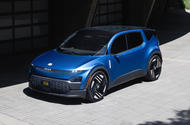Fisker claims the standard Pear will dispatch the 0-60mph sprint in 6.3sec
American EV start-up to begin deliveries of compact hatchback from July 2025
A “high-performance” variant of the Fisker Pear electric hatchback, dubbed the Pear Extreme, has been confirmed by the American EV start-up.
Fisker has yet to confirm performance targets for the new variant, but it’s highly likely to significantly reduce the 6.3sec (claimed) 0-60mph sprint time of the regular Pear, thanks to a dual-motor, four-wheel-drive powertrain.
For reference, the larger Fisker Ocean Extreme features a 275bhp motor on each axle for a combined 564bhp and 544lb ft. This allows the 2434kg SUV to reach 60mph from a standstill in 4.0sec.
Autocar expects that the Pear Extreme will be positioned as a rival to the £36,495 MG 4 XPower, whose 429bhp dual-motor powertrain allows it to hit 60mph in 3.7sec – faster than the entry-level Porsche Taycan and on a par with the Taycan GTS.
The Extreme is likely to feature the larger battery planned for the Pear. Fisker claims this yields a 348-mile range in regular variants, but this will doubtless be reduced in the high-performance model.
High-end versions of the Pear will also feature a solar-panelled roof, like that featured on the Ocean, to passively top up the battery with additional charge.
The cheapest variant of the Pear, on the other hand, will use a significantly smaller pack giving a claimed range of 198 miles.
This entry-level rear-wheel-drive variant, which Fisker expects to be the most popular, will be priced from $29,900 (before incentives) in the US. That equates to £23,500, although the on-sale price in the UK is likely to be slightly higher given local taxes and the cost of shipping the car from the Tawianese tech giant Foxconn’s factory in Ohio, US.
“In two years, you will see people realising they don’t need that [much] range, specifically if they have a second car,” said Fisker Inc founder Henrik Fisker. “There are a few cars out there that have a 100- to 150-mile range and aren’t selling,” he added.
The Pear’s low claimed entry cost is also attributable to its simple design: the 4550mm-long crossover (sized roughly in line with the Volkswagen ID 4) is based on a steel chassis said to use 35% fewer parts than a conventional platform. This platform will also give the Pear “sporty handling”, said Henrik Fisker.
Under the skin, it uses a dedicated computing architecture dubbed the ‘Blade’, which uses fewer, more centralised computers. Chief technology officer Burkhard Huhnke said in February that this approach reduces the material cost of the vehicle and “increases the performance drastically”. Chief financial officer Geeta Gupta-Fisker added the Pear will be “driven by software, not hardware”.
High-speed 5G networking makes the car a “cloud connected mini data centre”, according to a statement by the start-up, offering “multi-gigabit” networking speeds – although such capabilities are highly reliant on local infrastructure.
The Pear will also feature a barebones interior with “zero moving parts” according to Henrik Fisker: “We don’t have the typical centre console that you can open up, and the typical glove compartment, and all these types of things”.
This simplification extends to the instrumentation and infotainment, which is all displayed through a central touchscreen in similar fashion to the Tesla Model 3, Tesla Model Y, and the upcoming Volvo EX30. A large 17.1in display will be offered as an optional extra.
The interior will be offered in five- and six-seat configurations, with the latter swapping the front-row bench for a van-style layout with room for three occupants.
At the rear end, the Pear features a novel ‘Houdini’ boot, in which the tailgate folds away into the rear bumper. This “simplifies cargo loading in city parking”, according to Henrik Fisker. Additional storage is provided under the bonnet, where a small “drawer-like” cargo space is provided, with optional insulation said to be capable of keeping food hot or cold.
Initial deliveries of the Pear are currently scheduled to begin in July 2025. Right-hand drive examples are expected to go on sale in the UK by 2026.
The car, which was revealed earlier this month in near-production form – only the door-mirror cameras are “still under review” according to an official statement – will be shown at the Fisker Lounge in central Munich between 4 and 10 September, coinciding with the Munich motor show.
The Pear will also form “the basis” of Fisker’s ambition to produce a carbon-neutral car by 2027, the start-up said in a statement, hinting at the eventual release of a pared-back variant featuring more sustainable materials.
Additional reporting by Will Rimell







